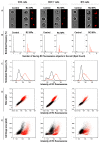Radachlorin-Containing Microparticles for Photodynamic Therapy
- PMID: 34513620
- PMCID: PMC8421630
- DOI: 10.34172/apb.2021.053
Radachlorin-Containing Microparticles for Photodynamic Therapy
Abstract
Purpose: Reducing the undesirable systemic effect of photodynamic therapy (PDT) can be achieved by incorporating a photosensitizer in microparticles (MPs). This study is devoted to the preparation of biocompatible biodegradable MPs with the inclusion of the natural photosensitizer Radachlorin (RС) and an assessment of the possibility of their use for PDT. Methods: RC-containing MPs (RС MPs) with poly(lactic-co-glycolic acid) copolymer (PLGA) matrix were prepared by a double emulsion solvent evaporation methods. The size and morphology of RC MPs were surveyed using scanning electron microscopy, confocal laser scanning microscopy, and dynamic light scattering. The content of RC, its release from RC MPs, and singlet oxygen generation were evaluated by the optical spectroscopy. Cellular uptake and cytotoxic photodynamic effect of RC MPs were investigated with in vitro assays. Results: The average diameter of the prepared RC MPs was about 2-3 μm. The RC MPs prepared by the water/oil/oil method had a significantly higher inclusion of RC (1.74 μg/mg) then RC MPs prepared by the water/oil/water method (0.089 μg/mg). Exposure of the prepared RC MPs to PDT light radiation was accompanied by the singlet oxygen generation and a cytotoxic effect for tumor cells. The release of the RC from the RC MPs was prolonged and lasted at least two weeks. Conclusion: PLGA RC MPs were found to cause a photoactivated cytotoxic effect for tumor cells and can be used for local application in PDT of tumors.
Keywords: Drug delivery systems; Microparticles; Photodynamic therapy; Photosensitizing agents; Radachlorin; Tumor cell line.
©2021 The Authors.
Figures
References
LinkOut - more resources
Full Text Sources









